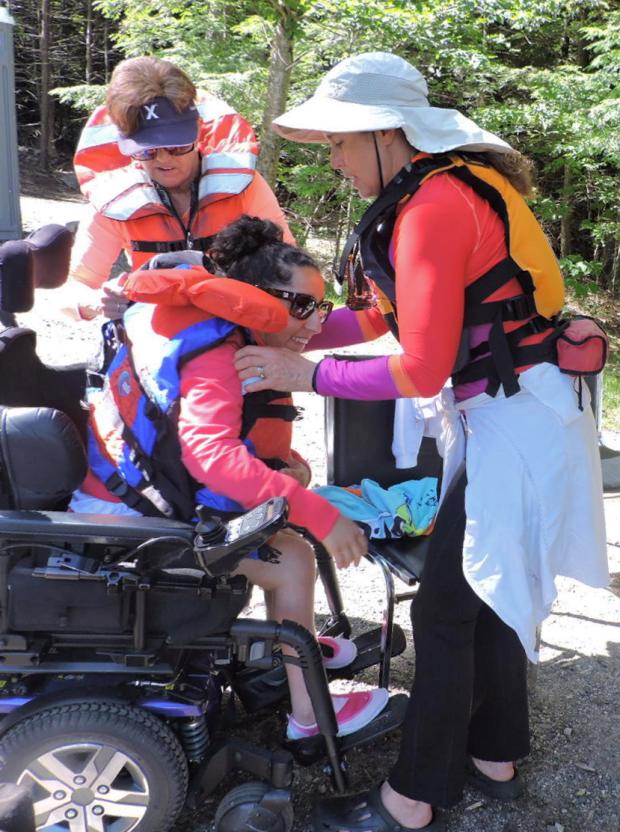What to expect and how to prepare
Our paddling sessions usually last for an hour and fifteen minutes, though longer day trips are sometimes available. Paddlers in a session go out together as a group, and move at the pace of the slowest paddler. The cost for programs ranges from $8 to $20.
Before you come paddling, you will need to pre-register with the organization that is offering the session you are interested in. During pre-registration, you will find out all of the skills you need to paddle that are outlined in our essential eligibility criteria for kayaking or canoeing. You will also fill out a release form and check in with the program leaders about what your needs and limitations are.
On the day of your session, you should come prepared for the weather and conditions of the day. This includes dressing for the elements and bringing your own sun and rain protection. It also includes bringing your own drinks and food. Our programs take place rain or shine, though we will cancel in extreme weather. Paddling programs take place out on open water away from shade, so you should make sure to protect yourself from the sun. We also have umbrellas that can be attached to your boat to give you additional shade.
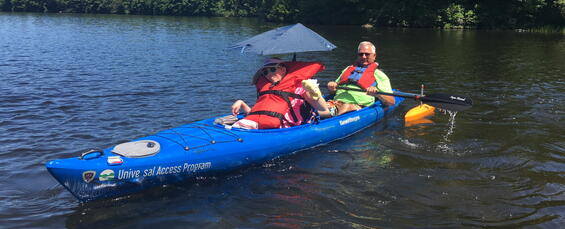
The paddler in the front of this tandem kayak is using an umbrella for shade.
You should also wear clothing that is durable and comfortable and that will give you some protection from the sun and water. It is a good idea to dress in layers, especially on top. Try to avoid clothes made of cotton, because cotton absorbs water and stays wet so you'll feel sweaty if it's hot and chilly if it's cool. Instead, wear wicking, quick-drying nylon or polyester, or another synthetic fabric. Wear clothes that let you move comfortably and will be comfortable for long periods of sitting. If you have one, a rashguard or water shirt are ideal for paddling because they’re quick drying, stretchy, and protect against damage from UV rays. But any comfortable shirt will work well. On your legs, board shorts or comfortable quick-dry pants are good options.
It's important to remember that you will need to wear footwear that can get wet, because you'll be stepping into and out of your boat on the water's edge. Sneakers are fine as long as you don't mind them getting wet, or you can wear water shoes or water sandals. It's a good idea to avoid shoes without a back strap, like flip-flops, because they will slip off your feet too easily.
If you have glasses, it's always a good idea to have them on a strap with a float in case they fall off your head. And hats are a great way to give you some sun protection and keep the sun out of your eyes, too.
Our paddling programs take place at sites that have been selected for the greatest accessibility possible. Accessible parking is provided near the program base, where we have a registration tent set up for protection from the elements. The path from parking to the registration tent may be paved and level, or it may be hard packed dirt with an incline as steep as a ramp. There are always restrooms available near the registration tent, either in a building or in a portable toilet unit.
After you arrive and park, you should check in at the registration tent, where you will be fitted for a personal flotation device (PFD), also known as a lifejacket. Our PFDs are vests that you wear that will keep the you afloat with your head and mouth above the surface of the water in case of a capsize. We have several different designs of PFDs, including some with head support that will make sure your head is upright if you are in the water.
Once you have your PFD on, you can get into your boat. The path from the registration tent to the water may use beach mat laid over sand, or it may be a paved boat ramp or hard packed dirt. Program staff will help you get into your boat and get you set up to paddle. You might need to wait a few minutes in your boat while other participants get set up. Then it's time to head out on the water with your group! You'll stay close to program staff and the other paddlers out on the water and move at the pace of the slowest paddler. Our paddling sessions usually last for about an hour, though we sometimes offer longer day trips, too.
Staff instruction and support
We welcome paddlers of all experience and ability levels! If this is your first time paddling, or if you would like some pointers on your paddle strokes, our staff will teach you how to hold your paddle and how to do some basic strokes. When you're paddling, you'll want to use your torso and stronger core muscles as much as possible, instead of the weaker muscles in your arms. If you're not able to paddle the traditional way, our staff will work with you to figure out which techniques, adaptations, and supports will give you the best paddling experience.
There are many great resources online to learn the basics of paddling technique. If you're interested in reading up on the basics before you get on the water, check out this beginner's guide to kayaking, this beginner's guide to canoeing, or search the web for tutorial, guides, and videos that you like.
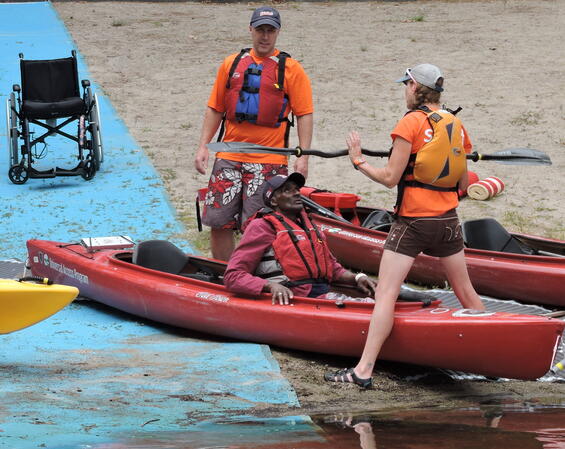
Our staff can teach you paddling techniques.
If you need assistance getting into a boat, we have staff and gear to help. A cooler and transfer board can help get you from your chair to the seat. We also have a Kayak Chariot with large balloon tires that allows transfers on the beach by lifting the boat cockpit rim up to wheelchair height. A transfer bench is used with the Kayak Chariot to give a flat, smooth transfer surface the same height as your chair. The bench can support you in an independent transfer or during an assisted transfer. You slide onto to a transfer board that is positioned directly above the boat seat. Adjustable handles let you push up to take your weight off of the middle section of the transfer board, which is then removed so you can lower down onto the boat seat.
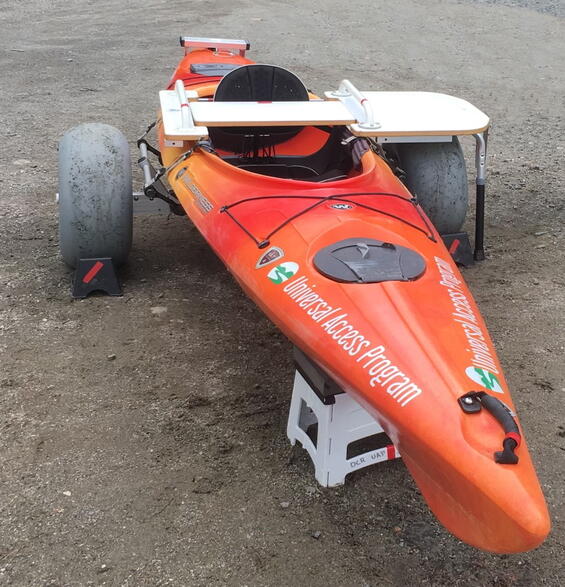
The transfer bench set up on a kayak with the Kayak Chariot.
Once you are in the boat, our staff will roll you into the water, unhook the wheels, and you are ready to paddle off.
Kayaks
We have many types of kayaks to chose from. Some of our kayaks are single kayaks for independent paddlers, and others are tandem kayaks for pairs of paddlers to work together.
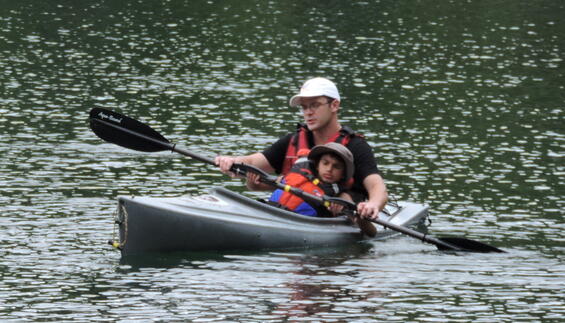
These paddlers are sharing a single kayak.
In a tandem kayak, you can join in on the paddling or just enjoy the ride as the other paddler moves the boat through the water. Some tandem kayaks are large enough that you can be supported by another paddler instead of sitting on your own seat.
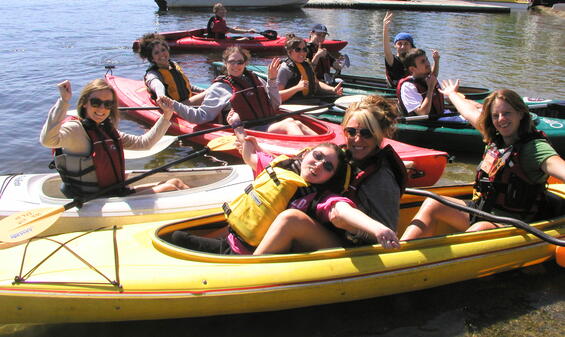
These single and tandem kayaks have wide, open cockpits.
Many of our kayaks have wide, open cockpits that make it easy to get in and out of the boat and which offer more room for transfers and adaptations. Kayaking programs with Waypoint Adventure include kayaks with smaller cockpits that offer more control and protection from the elements.
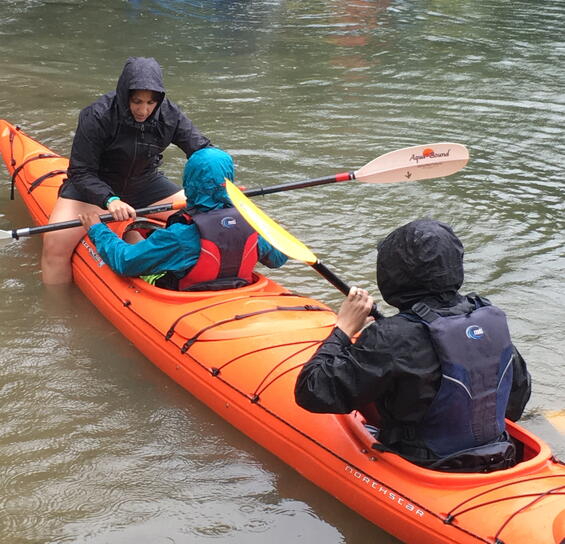
This tandem kayak has smaller cockpits.
Canoes
Our canoes range in length from 13 to 17 feet. These canoes have been designed for stability with wide, flat hulls that keep them steady in the water. The cockpits are large and open, giving lots of space for transfers and adaptations. Our canoes are usually paddled by two paddlers, though our experienced paddling staff can also paddle alone.
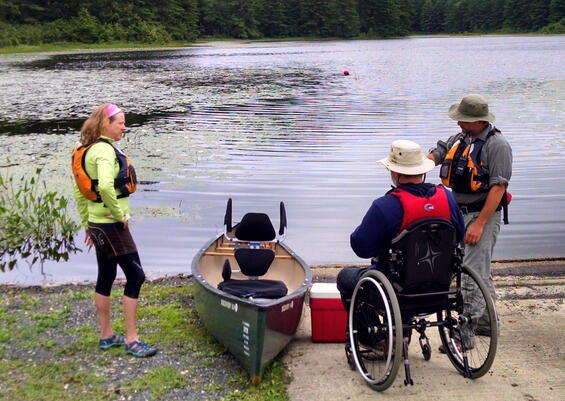
A paddler prepares to transfer into a canoe.
The front of a canoe is called the bow, and the back is called the stern. You can sit on a traditional seat in the bow or the stern of the canoe, where you are raised up above the water. If you need trunk support, you can use the Universal Paddling Seat. If you need more support, you can sit in the bottom of the canoe so that you are surrounded by the sides of the hull.
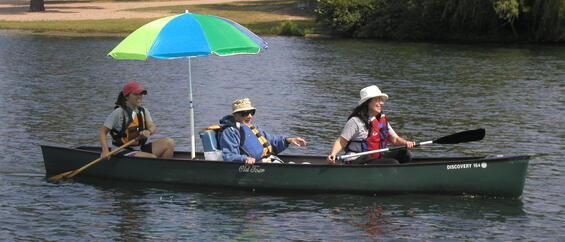
You can sit on the bottom of a canoe and be supported by a custom seat.
Stabilizing outriggers
Outriggers make a boat more stable by widening the base of the boat in the water. Outriggers can be mounted to the center of any canoe and to the back of many of our kayaks, which makes sure they're out of the way of the paddles.
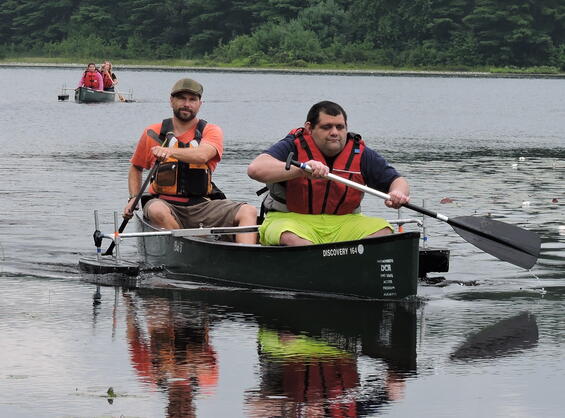
Both of these canoes are using outriggers.
The outriggers can be adjusted to be tight to the hull for maximum efficiency, or further out out from the hull for maximum stability. They can be adjusted to different heights, and the kayak outriggers can change angle to prevent drag and make paddling easier.
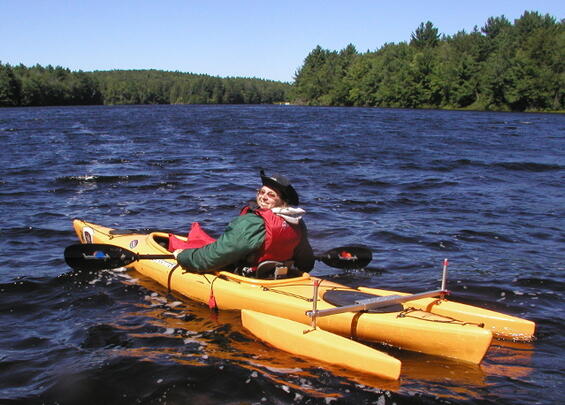
Outriggers on a kayak can be angled to reduce drag.
Seating and padding
The Universal Paddling Seat from Creating Abilities was designed to offer varying levels of support depending on your need. Separate upper and lower sections offer supports for either the lower back, or the lower back and the upper back. Lateral pads can be added at either level to give support where you need it, on one side or both sides.
The Universal Paddling seat from Creating Abilities is set up here with full support for the back and sides.
Each support point of the seat can be independently tilted, adjusted or removed to create a custom fit. All supports are cushioned with closed-cell foam and covered in breathable mesh fabric for skin protection. The seat can be mounted on canoes or kayaks.
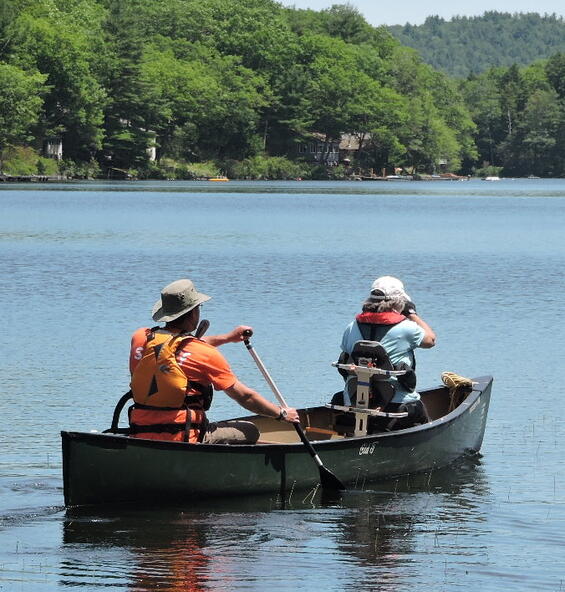
This paddler is using the Creating Abilities paddling seat with the full level of support.
A custom paddling seat for canoeing offers back support and cushioning for paddlers who sit on the bottom of the canoe, where there is greater stability and support. If you need more support than a seat can offer, you can be supported by a companion sitting on the bottom of the canoe.
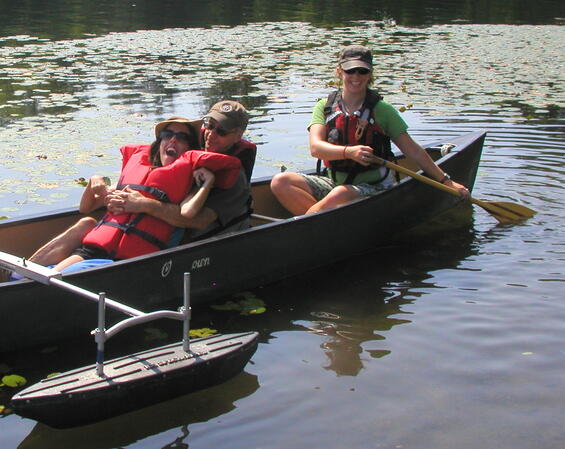
Companions can also offer seating support in a canoe.
Cushioning and positioning are very important for skin safety and effective paddling. We custom fit pads and cushions to you and your boat to make sure that you are comfortable, and that the force of your paddling is turned into momentum on the water.
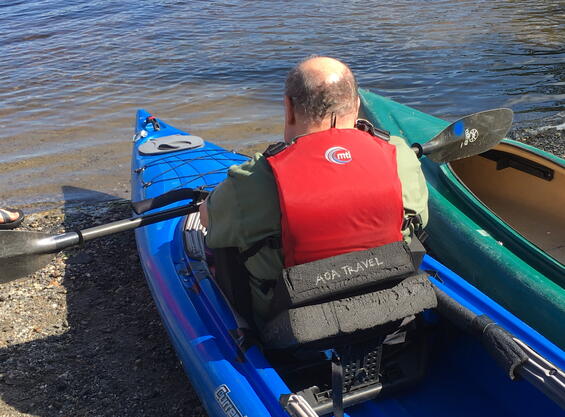
Foam wedges provide posture support and comfort while paddling.
We have many different styles and types of padding to match your body and protect your skin, while making sure that you have the best fit with the boat and the gear. You can bring your own pad or cushion into the boat, or use the Sweet Cheeks seat form. This adjustable, inflatable cushion goes under you and fits around you to make a perfect bucket seat. There are no pressure points, and you won't slide around on your seat.
Foam is used to fit you to the boat and protect your skin.
Paddles and paddle adaptations
We have many different styles of paddles, including lightweight carbon fiber paddles with ergonomic shapes designed to reduce the strain on your joints. Our kayak paddles are painted to help you remember which blade is left and which is right, and to keep them pointed the right way to pull you through the water. We have both wooden and light-weight metal and plastic canoe paddles of many sizes. Canoe paddles bent in an S-shape let you paddle while keeping your hands low if you have trouble raising your arms.
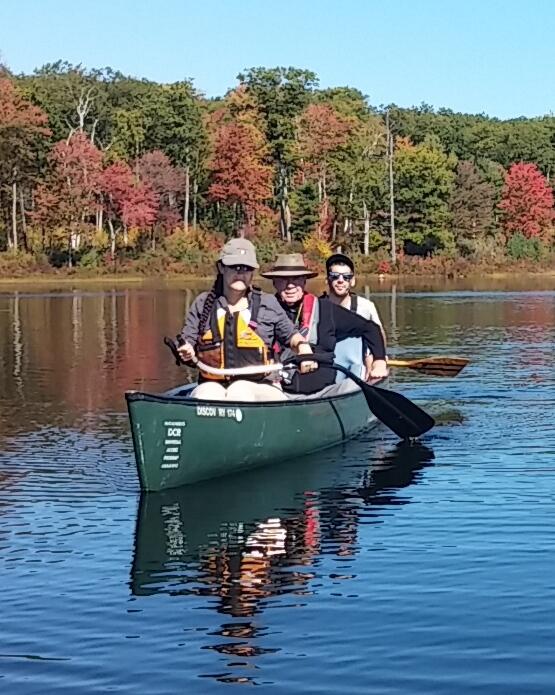
This canoe paddle is bent to change the kind of force needed for a paddle stroke.
We also have several hand adaptations to help with supporting and gripping paddles.
The basic hand grip.
A basic grip that runs along the back of the hand works well if you have some hand function but need support to keep your hands on the paddle. Your hands slide in and out from the sides and are held in place comfortably with the padded grips. The tension on the grips can be adjusted to fit your hand and your stroke.
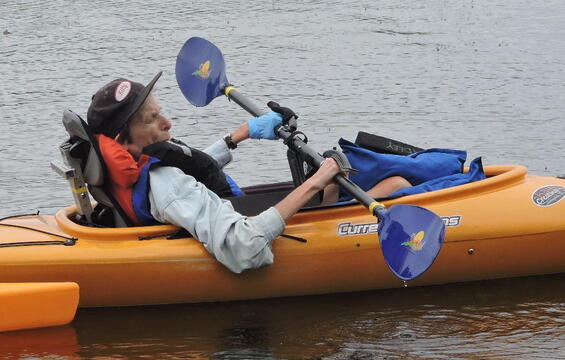
The basic hand grip in action.
If you can't grip the paddle but have good function in your arm, you can use a hand cuff that slides into an attachment added on the paddle shaft. The cuff buckles around your wrist and keeps the paddle connected to your arm.

This paddler has an attachment on their paddle that connects to a cuff on their arm.
Your hands are held in place on the paddle even if your fingers can't grip the bar, and your arms can be used to paddle. If you need to do a wet exit or let go of the paddle quickly, you can slide the cuff out of the attachment.
A close up of the adjustable cuff that attaches your hand to the paddle.
The Paddle Pivot attaches in the middle of the boat and allows you to paddle with one arm. It also gives support to completely remove the weight of the paddle from your arms when using both arms to paddle. The pivot assembly snaps onto any paddle shaft. The paddle and pivot assembly lift out of the base for ease of entry and safety in the event of a wet exit.
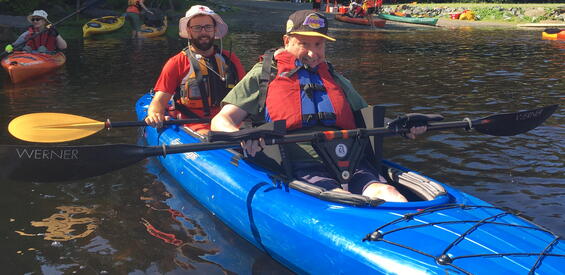
The paddler in front is using a paddle pivot to hold their paddle, along with some hand grips.
Paddling program schedule and locations
Our adaptive paddling programs are offered weekly in July and August at several different parks. The locations may change from season to season, but typical paddling spots are listed below. To see the current program schedule and register for current programs, please visit our adaptive program schedule. If you would like to get on our mailing list to find out about upcoming paddling opportunities, please contact us.
Cochituate State Park in Natick
DAR State Forest in Goshen
Quinsigamond State Park in Worcester
Walden Pond State Reservation in Concord
